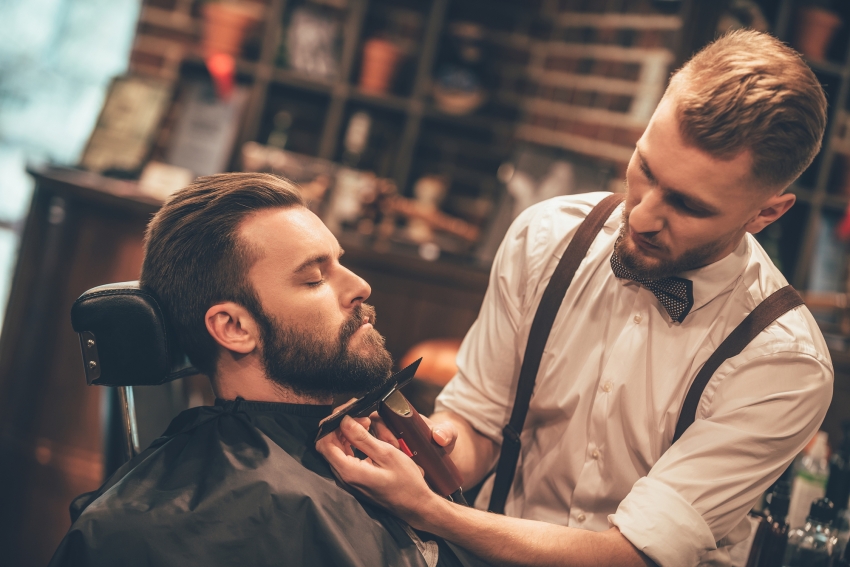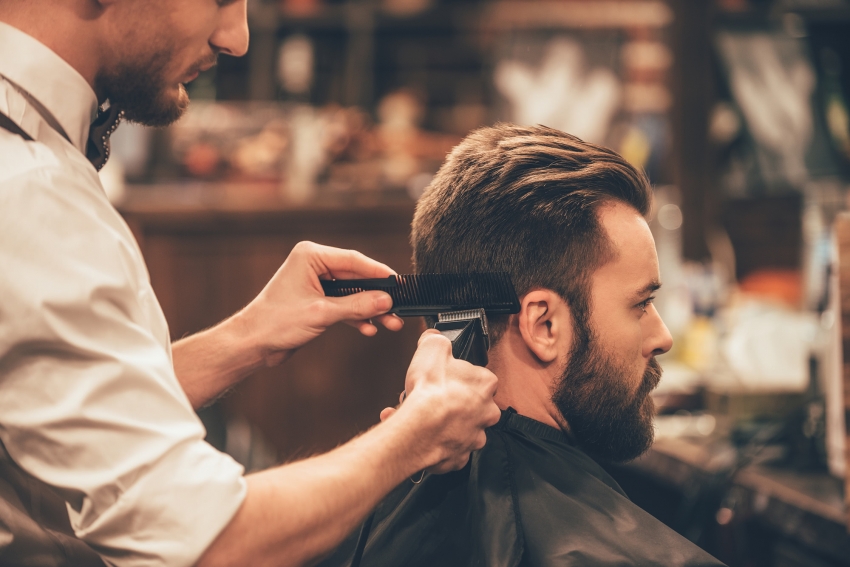If you have an artistic flair, a passion for hair, and dislike the “normal” 9-5 life, then you should consider becoming a barber.
Barbers are specialized in hair treatments and grooming, typically focusing on male hair.
Although it might be a “non-traditional” career, there is a certain educational path that you must follow.
That’s why we put together this comprehensive guide on how to become a barber.
Read on to figure out the exact steps you need to become a hair care professional.
Steps to Becoming a Barber
Here are the basic steps to becoming a barber:
Step 1: Complete a program/apprenticeship
The first step is to get an education in either a barber program or a cosmetology program. Barber programs are more focused on male-hair care while cosmetologist programs focus on hair care and other beauty applications. Depending on the state, you could also get an apprenticeship with a state-licensed barber.
Step 2: Pass the license exam
Every state requires prospective barbers to pass a state-approved license exam. These exams usually involve both a written and practical component. Some states allow those with cosmetology degrees to take the barber license exam without having completed a barber program.
Step 3: Maintain your license
After passing the state-license exam, you must maintain your license. Most states require you to renew your license every year and provide proof of completing continuing education credit hours.
Barber Education Requirements
Becoming a professional barber requires either completing a state-approved barber program or completing an apprenticeship.
Both programs and apprenticeships involve a large amount of hands-on experience so a good deal of your education will be spent working on actual clients under the supervision of a licensed professional barber.
In general, there are no hard and fast rules surrounding barber education. You can get a job without attending a formal program, though formal programs often better prepare students for state-mandated license exams.
Barber education is very similar to cosmetologist education. Both barbers and cosmetologists focus on hairstyling, hair treatment, and hair grooming practices. Barbers, however, focus more on male beard grooming and shaving while cosmetologists learn about other beauty applications like nail and skin treatments.
Many states allow licensed cosmetologists to apply for barber licensure without having to complete a barber program.
Most states require barbers to pass a state-approved licensure exam before they can work on their own as a barber.
Exact licensure requirements differ from state to state but most states require a minimum age, a certain number of hours worked, and a practical exam.
For example, the state of Connecticut requires license applicants to complete a program that is at least 1,500 hours in duration while Florida requires students to complete a 1,200-hour program.

Accreditation
Students who want to pursue a career as a barber must graduate from a program that is accredited by a nationally recognized accreditation organization or is recognized by the state department of barbering.
The most recognized national agency for barber program accreditation is the National Accrediting Commission of Career Arts and Sciences (NACCAS). NACCAS-approved barber programs are eligible for federal funding and offer federal financial aid to students.
Other accrediting agencies recognized by the US Dept. of Education include the Accrediting Commission of Career Schools and Colleges (ACCSC) Accrediting Council for Continued Education & Training (ACCET) and the Council on Occupational Education (COE).
Other than these nationally recognized agencies, each state has its own barber board that approves accredited programs.
Training Information & Types of Barber Degrees
There are two main education paths to become a barber. First, you can attend a barber education program then sit for the state licensing exam.
Alternatively, you could become a barber by pursuing a cosmetology degree. Many states allow those who hold cosmetology degrees to take the barber license exam without having to complete a separate barber program.
However, cosmetologists may be required to take a few extra courses to be eligible to sit for the state barber exam.
If you are more interested in just being a barber your best bet is to just attend a solid barber program. However, if you are interested in being a barber but also want to keep your career options open, you could consider pursuing a cosmetology degree and getting your barber license.
Some states will allow you to complete a barber apprenticeship to sit for the exam in lieu of completing a formal program. An apprenticeship must be completed under the supervision of a state-approved and licensed barber.
Some states, like New Hampshire, require both a degree and an apprenticeship.

What You’ll Study
Barbers are trained in the grooming of (predominantly male) hair and facial hair. Barbers learn how to properly cut, style, and maintain hair and beards, hair care techniques, and diagnosing hair and scalp conditions.
Barbers focus specifically on different shaving techniques, including safety razors and straight blade shaving. Barbers also learn about chemically straightening hair, applying hair tonics, and how to measure, fit, and cut hairpieces.
Most barber programs are very hands-on so the majority of your time will be spent working on actual customers.
Courses are often built on a theory-practice model in which the first half of the lesson is lecture-focused about hair techniques and the rest is devoted to practicing learned techniques.
Most programs also incorporate professional and business-oriented courses that focus on client interaction and running your own barbershop.
They also tend to add in basic English composition and communications courses. Any barber program worth its salt will include training in:
- Men’s haircutting (taper, buzz, trim, fades, etc)
- Scalp treatments (shampooing, scalp massage)
- Hair coloring
- Chemical techniques
- Client interaction
- Safety, hygiene, and regulations
- Salon management
If you decide to go the cosmetology program route, then you will also take courses focusing on other aspects of beauty care, such as nail coloring, facial treatments, makeup, and more.
How Long Does it Take to Become a Barber?
Most states require prospective barbers to have completed a formal degree program consisting of at least 1,500 hours of instruction. The average barber program can last anywhere from 9-24 months. Factoring in a few months to study for the license exam and to find a job, you can start working as a full-fledged barber in as little as a year.
If you pursue an internship, then you will start working as a barber immediately, albeit in a subordinate role under a supervisor. Apprenticeships usually take about 2 years to complete, though this can vary by state.
How Much Does it Cost to Become a Barber?
Barber programs vary significantly in cost depending on the area and can range from $2,000 to more than $11,000. Generally, schools offer reduced tuition for in-state residents. Aside from tuition, barbers must also buy their own equipment and supplies, and pay any program application and license application fees. Students attending accredited barber programs may be eligible for federal financial assistance.
Option 1: Barber Certificate/Diploma
The “basic” educational option for barbers is to pursue a barber certificate/diploma program. (quick note: barber “certificate” and “diploma” programs are basically synonymous).
These programs are typically short and can be completed in about a year or less. Barber certificate programs focus on the basics of hair care and styling and include courses on how to cut and style hair, hair care techniques, and how to trim and shave beards and facial hair.
By the time you finish a barber certificate program, you will be qualified to take the state-mandated barber license exam.
Aside from technical barber skills, certificate programs usually devote some time to teaching the basics of salon management and professional development.
Students will learn the ins-and-outs of running a barbershop and how to interact with customers.
Admission Requirements
Most barber certificate programs require applicants to have at least a high-school diploma/GED and be 16 years of age. Some programs may require applicants to take a test to show English proficiency.
Other than that, there are no real requirements to apply to a barber certificate program. There are generally no prerequisite courses to complete and schools usually do not require standardized test scores.
Courses
A hypothetical course load for a barber certificate program might look like:
- Anatomy/physiology
- Sanitation and hygiene
- Chemical procedures
- Business and professional relations
- Haircutting, shaving, and styling
Certificate programs are very focused and not deviate much from the core skill set barbers need to succeed in the field.
Option 2: Cosmetology Degree
The other main option for becoming a barber is to attend a cosmetology program.
Cosmetology programs cover a lot of the same ground as barber programs, including hair treatments, hair styling, chemical treatments, and shaving/beard care. However, cosmetologists also take courses on other beauty applications like nail treatments, facials, makeup, and more. These programs also cover the basics of running your own salon/spa.
Cosmetology programs can last anywhere between 9 months and 2 years. Cosmetology programs are offered at technical colleges, vocational schools, community colleges, and traditional 4-year universities.
Many states allow those who possess a degree in cosmetology to sit for the barber license exam without having completed a barber program. Generally, such license candidates have to take a few extra courses focusing on barber-specific techniques.
Admission Requirements
Most cosmetologist programs only require that applicants be at least 16 years of age.
This means that you can start cosmetology school while finishing your last two years of high school.
However, most cosmetology programs may require you to have a high school diploma by the time you graduate, and many employers want candidates who have at least a high-school degree.
Very rarely, cosmetology programs may require some prerequisite courses and might require you to demonstrate some basic competency in reading, writing, and math.
Courses
A cosmetology program curriculum might look like:
- Shampooing
- Fundamentals of skin disease and conditions
- Hairstyling techniques
- Esthetics (makeup)
- Skin treatments
- Business law/ethics
Overall, you cover a lot of the same ground as a barber program with extra instruction on other beauty applications.

Online Barber Programs
Since being a barber is a rather hands-on profession, options for fully online barber/cosmetology programs are limited.
Most states require license applicants to complete a certain number of practical hours, so you cannot get your entire barber training online. However, distance learning and online courses can be found for licensed barbers seeking continuing education credits. Commonly offered online barber course might include:
- Barbering and cosmetology law
- Safety and sanitation
- Beauty industry business
How to Get Your Barber License
Each state requires barbers to pass a state-approved licensure exam.
These license exams differ from state to state but normally involve giving proof of completion of a 1,200-hour program, proofs of a certain number of hours worked, and pass an exam with written and practical components.
Some states, like New York, allow license applicants to have completed an approved apprenticeship program in lieu of completing an educational program.
Further, if you already hold a barber’s license in another state, some states will allow you to transfer your credentials with little to no extra work.
These specifics vary by state so make sure you do thorough research on the license requirements for your state.
License Renewal
Most states also require you to renew your license every year or two.
Normally, renewal involves offering proof of completed continuing education credits and a license renewal fee. If you wait too long to get your license renewed, you may be required to take the entire license exam again.
Barber Job Outlook & Growth
Barbers face decent starting salaries and good potential for career growth. According to the US Dept. of Labor Statistics, the annual median salary for barbers in 2018 was $24,830 ($11.94/hour).
Interestingly, out of all other hairstylist professions (hairdressers, cosmetologists, etc.), barbers have the highest average hourly pay at $13.44.
These figures are estimates as many barbers also receive a large number of cash tips from customers that may not be reflected in BLS data.
A fair amount of barbers are self-employed and set their own hours. Work is usually on a per-client basis so many barbers work irregular hours including nights and weekends.


One Response
PLZ SEND ME THIS LINK & MORE INFO ON BECOMING A LIC BARBER